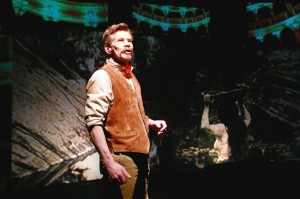The Edward Curtis Project: Visually stunning piece tackles a complex topic

Photo: Julie Oliver, Ottawa Citizen
Métis playwright Marie Clements is a gifted storyteller who draws on the traditions of her Aboriginal roots as well as Western theatrical techniques to weave together highly visual stories that link the past and present; personal and collective. Although there are some kinks to be worked out, her latest effort, collaboration with photojournalist Rita Leistner The Edward Curtis Project, manages to situate the extremely complex issue of Aboriginal identity rooted in history, theory and representation into a contemporary sphere that is accessible and touching to watch.
In her latest work, the playwright uses the work of Edward Curtis, the-turn-of-the-20th-century photographer famous for documenting the “Vanishing Indian,” to dissect and challenge non-Aboriginal constructions of Aboriginal identity. Curtis travelled all through North America, taking photographs of Aboriginal peoples in dreamy settings, complete with wigs and props he provided. The problem, as Clements’ play so aptly shows, is that these idealised images, from a white, colonial, limited-lens perspective, became the “real culture” for Aboriginals and non-Aboriginals alike; an entire continent of people trapped in a false, simplified past.
The Edward Curtis Project centres around a journalist named Angeline (a character Quellemia Sparrow infuses with energy, depth, and longing), a mixed-race child of Dene and Russian descent in the midst of a breakdown, though she calls it a breakthrough. As a journalist covering Aboriginal issues, Angeline is haunted by a story she reported on in Canada’s far north about the deaths of three children left to freeze in -38 degree weather by their drunken father. Guilt-ridden that her story presented only facts without context, she falls into a debilitating depression.
When Angeline’s well-meaning sister gives her a coffee table book of Curtis’ photographs, the full force of history, identity, representation, and misrepresentation hits Angeline. In her despair, she identifies herself with the “Vanishing Indian” and starts hallucinating conversations with Curtis (a convincing, delightfully charming Todd Duckworth). Intertwined with this narrative are scenes from Curtis’ life.
All of the actors play multiple roles to some extent and, often, the change from one character to another is almost unnoticeable. One second, Kevin Loring is Angeline’s patient, loving boyfriend in the present and the next he is a man telling Curtis to get off his land and out of his face at the turn of the 20th century. At first glance, one would automatically assume that some of these transitions aren’t clear enough.
However, this would be in direct opposition to one of the play’s main messages‒that no matter what time or place we occupy, who we are is based on our experiences, as well as the collective experience history has placed upon us. Of course there are no clear transitions between a Dene man living in the present and a First Nations chief living over 100 years ago. Space and time become irrelevant because we are all part of one another, connected by history. The play’s characters, while living in the present, carry the weight of history and experience on their shoulders.
The creative team takes a visual approach to the subject matter, as fitting a collaboration between a playwright and a photojournalist. The action is framed by transparent screens in Ivo Valentek’s versatile set and is capped by Tim Matheson’s photography placement. Curtis’ and Leistner’s works are juxtaposed at different points of the play, yielding some perfectly poignant and reflexive moments, as when Angeline writes Curtis-like captions underneath her own family portraits with the movement of her hand.
The production is brought together by John Webber’s imaginative lighting design and Bruce Ruddell’s music and sound. Webber shatters glass, creates a snowstorm, and mimics the camera’s flash with a trick of light, each instance further underlining the play’s message. Ruddell’s score is haunting and the inclusion of Aboriginal songs is a nice touch. Webber and Ruddel’s make the sound and light a performance alongside the set and script.
As its name implies, The Edward Curtis Project is a work in progress. However, overall the play is a complete experience and an intimate exploration of a woman trying to find where she fits into the world as an Aboriginal person. Clements and Leistner have managed to transform the topic into something universal – an exploration of identity that is rooted in the Aboriginal experience, but that also extends beyond purely racial lines to encompass its creation though time, space, and history.
The Edward Curtis Project plays at the Irvin Greenberg Theatre until April 22. Buy tickets in person or call the GCTC Box Office at 613-236-5196.
The Edward Curtis Project
Based on the original production commissioned and produced by Presentation House Theatre (Vancouver, BC)
NAC English theatre/Great Canadian Theatre Company co-production
THE CAST
Kathleen Duborg: Clara Curtis/Dr. Clara
Todd Duckworth: Edward Curtis/Chief
Kevin Loring: Yiska/Translators
Quelemia Sparrow: Angeline
THE CREATIVE TEAM
Marie Clements: Playwright/Director
Ivo Valentik: Set Designer
Barbara Clayden: Costume Designer
Bruce Ruddell: Composer and Sound Designer
John Webber: Lighting Designer
Jamie Griffiths: Projection Designer
Jan Hodgson: Stage Manager
Rita Leistner: Photojournalist
Tim Matheson: Production Photographer and Projection Designer
Sarah McVie: Assistant Director
John Doucet: Assistant to the Set Designer
Troy Slocum: Assistant Sound Designer
Jessica Preece: Apprentice Stage Manager
One Reply to “The Edward Curtis Project: Visually stunning piece tackles a complex topic”